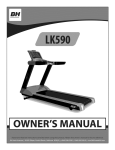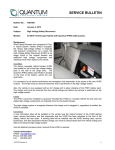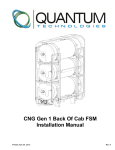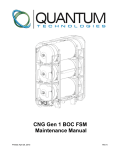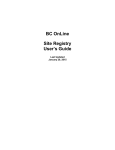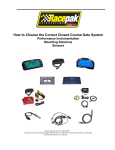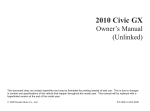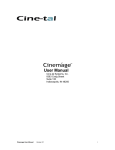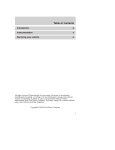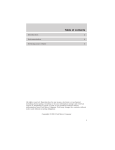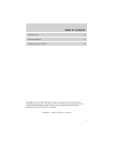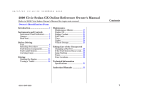Download CNG Gen 1 Frame Mount FSM Maintenance Manual
Transcript
CNG Gen 1 Frame Mount FSM Maintenance Manual Printed April 21, 2015 Rev F CNG Gen 1 Frame Mount FSM Maintenance Manual Preface To reduce the chance of personal injury and/or property damage, the following instructions must be carefully observed: Proper installation, service, and repair are important to the safety of the service technician and the safe, reliable operation of all motor vehicles. If part replacement is necessary, the part must be replaced with one of the same part number or with an equivalent part. Do not use replacement parts of lesser quality. The procedures recommended and described in this Maintenance Manual are effective methods of performing a proper maintenance of the fuel storage module (FSM). Accordingly, anyone who intends to use a replacement part, procedure, or tool which is not recommended in this manual, must first determine neither his safety nor the safe operation of the vehicle will be jeopardized by the replacement part, procedure, or tool selected. It is important to note that this manual contains “Cautions” and “Notices” that must be carefully observed in order to reduce the risk of personal injury during maintenance, or the possibility that improper maintenance may damage the vehicle or render it unsafe. It is also important to understand that these “Cautions” and “Notices” are not exhaustive, because it is impossible to warn of all the possible hazardous consequences that might result from failure to follow these instructions. The system must only be installed, operated, and maintained by trained personnel who have read and understood this manual. Individual operator training is the responsibility of the company, firm, or organization placing the system in service. If you need further information or have any questions, please contact: Quantum Fuel Systems Technologies Worldwide, Inc. 25242 Arctic Ocean Drive Lake Forest, CA 92630 USA Tel: 949.930.3400 Fax: 949.930.3401 All information, illustrations, and specifications are based on the latest product information available at the time of printing. Quantum Fuel Systems Technologies Worldwide, Inc. reserves the right to make changes at any time without notice. This information is the intellectual property of Quantum Fuel Systems Technologies Worldwide, Inc. and may not be altered in any way. This information is protected by the copyright laws of the United States of America, and other countries, and may not be reproduced, stored in any retrieval system, or transmitted in any form or by any means (including but not limited to electronic, mechanical, photocopying, and recording) without the prior written permission of Quantum Fuel Systems Technologies Worldwide, Inc. 2015 Quantum Fuel Systems Technologies Worldwide, Inc. i CNG Gen 1 Frame Mount FSM Maintenance Manual How to Use This Manual This supplement contains information specific to the CNG Frame Mount fuel storage module (FSM). It does not explain everything you need to know about servicing your equipment. You must use this maintenance manual along with the service manual for the other installed components. Only then will you be able to properly operate and maintain your equipment. This manual contains information for the CNG Gen 1 Frame Mount fuel storage module. ii CNG Gen 1 Frame Mount FSM Maintenance Manual Ordering Parts To purchase repair or replacement parts for the CNG Gen 1 Frame Mount Fuel Storage Module, contact your local Quantum sales representative. Technical Assistance For questions regarding the installation, maintenance, and service for the CNG Gen 1 Frame Mount Fuel Storage Module, contact Quantum Technical Assistance at 800.816.8691. Price List Published prices are accurate at the time of print and are subject to change without notice. For part pricing, contact your local Quantum sales representative. This manual is for use only for the following FSM Part Numbers: PN 114278 25X60” RH FSM PN 114482 25X80” RH FSM PN 114233 25X90” RH FSM PN 116241 25X60” RH FSM, SLAVE PN 116102 25X80” RH FSM, SLAVE PN 114985 25X90” RH FSM, SLAVE PN 116646 25X90” RH FSM, W/ REGULATOR PN 115240 25X80” LH FSM PN 114790 25X90” LH FSM PN 116263 25X60” LH FSM, SLAVE PN 115306 25X80” LH FSM, SLAVE PN 115533 25X90” LH FSM, SLAVE PN 116647 25X90” LH FSM, W/ REGULATOR PN 117034 25X90” LH FSM, HIGH FLOW iii CNG Gen 1 Frame Mount FSM Maintenance Manual Module Identification Generation 1 114278, 114482, 114233, 115240, 114790 – Fill Panel 116241, 116102, 114985, 116263, 115306, 115533 – No Fill Panel (Slave) 116646, 116647 – W/ Regulator 117034 – High Flow All of the Generation 1 Frame Mount FSMs will have a lower cover that is not equipped with bolts that attach the lower cover to the cylinder mounting brackets. There will only be cover bolts along the perimeter of the lower cover. The Generation 1 Frame Mount FSMs which are equipped with a regulator and fuel control module are identified with 6 bolts on the rear end cap. The 2 lower bolts on the end cap are used to mount the regulator. The 4 upper bolts on the end cap are used to mount the bracket for the fuel control module. The Generation 1 Frame Mount FSMs that are built for high flow capacity can be identified with the check valve and mount attached to the inside of the rear end cap. iv CNG Gen 1 Frame Mount FSM Maintenance Manual Table of Contents Safety ..............................................................................................................................................................................1 System Overview ...........................................................................................................................................................3 About Natural Gas .........................................................................................................................................................3 Service and Maintenance ..............................................................................................................................................4 Maintenance Schedule ..................................................................................................................................................4 Maintenance Inspections and Procedures ....................................................................................................................6 Cylinder Movement Inspection ...................................................................................................................................6 Fill Receptacle O-Ring Inspection ..............................................................................................................................7 Coalescing Filter Maintenance ...................................................................................................................................8 Fuel System Inspection ............................................................................................................................................10 Cylinder Bracket and Isolator Inspection ..................................................................................................................11 Cylinder Inspection ...................................................................................................................................................12 Fuel Storage Module Inspection ...............................................................................................................................13 Service Components and Procedures .......................................................................................................................14 CNG Fuel Storage Module Access .............................................................................................................................14 Fuel Storage Cylinder Manual Shut-Off Valve ............................................................................................................14 CNG Fuel Storage Module Manual Shut Off Valve .....................................................................................................15 CNG System Vent Valve .............................................................................................................................................15 Fill Check Bypass Valve ..............................................................................................................................................16 Fuel Cylinder Handling Instructions ..........................................................................................................................17 Purge Instructions .......................................................................................................................................................18 Cylinder Initial Pressurization/CNG Cylinder Valve Initial Interface Leak Test ...........................................................19 Filling your Fuel Storage Module ................................................................................................................................21 Low Ambient Temperature Vehicle Refueling .............................................................................................................23 Refueling Problems .....................................................................................................................................................24 Leak Checking the System..........................................................................................................................................25 Fuel Cylinder Venting ..................................................................................................................................................26 Long Term System Storage ........................................................................................................................................28 Collision Repairs .........................................................................................................................................................28 Removing Cylinders From Service ..............................................................................................................................29 Limited Warranty For Composite Cylinders, Parts & Components ........................................................................30 Appendix A - Cylinder Inspection Form ....................................................................................................................31 v CNG Gen 1 Frame Mount FSM Maintenance Manual This Page Intentionally Left Blank vi CNG Gen 1 Frame Mount FSM Maintenance Manual Safety Important Safety Information Read this manuals safety precautions before servicing this system. Failure to do so could result in serious injury or death. CNG is extremely flammable. If something ignites it, you could be severely burned. Keep sparks, flames and ignition sources a minimum of 5 meters from CNG. Ensure work area is well ventilated. Always wear proper eye and hearing protection when working with pressurized gas. Use explosion proof drop lights when working on gaseous fueled systems. Failure to follow these basic safety guidelines may result in serious personal injury or death. This is the safety alert symbol. It is used to alert you to potential personal injury hazards. Obey all safety messages that follow this symbol to avoid possible injury or death. 1 CNG Gen 1 Frame Mount FSM Maintenance Manual Important Safety Information (Cont) CNG is stored at pressures up to 3,600 psi (25 MPa). Verify all pressure is properly vented from any fuel cylinder or fuel line before proceeding with disassembly. Failure to properly vent fuel system components could result in minor or moderate injury. When filling your vehicle, keep sparks, flames and ignition sources a minimum of 5 meters from the refueling area which could result in minor or moderate injury including the risk for severe burns. Do not smoke near CNG or while refueling a system. Turn the system’s electrical system OFF while refueling. Refuel CNG fuel cylinders in a well-ventilated area. Keep mobile phones at a distance from the refueling area. Do not fill the fuel storage module with CNG if the cylinder pressure is less than 363 psi (2.5 MPa) AND the cylinder temperature is less than -31°F (-35°C). Refueling under these conditions may cause personal injury and equipment or system damage Allow the fuel storage module temperature to rise above -31°F (-35°C) before filling. Using a common automotive or plumbing O-ring as a replacement part could cause a leak while operating the system on CNG. If something ignites the leak, you could be burned. Use only CNG certified O-rings from an authorized source. In the Event of Equipment Fire If a fire should occur in the vicinity of the cylinder system, the pressure relief device located in the cylinder may be activated. If the pressure relief device activates, very rapid venting of gas may occur. If a fire caused the activation and the cylinder is full of a flammable gas, it is likely that the gas exiting the pressure relief line will ignite and can be very dangerous. Even if the gas does not ignite, debris blown about by the gas jet could be dangerous and the loud noise caused by the rapid venting could cause hearing damage. If the pressure relief device activates, evacuate the area immediately and call the appropriate authorities. Once the pressure relief device has been activated, the cylinder must be returned to Quantum Technologies for inspection, disposition, and service. Safety Features The CNG fuel system has been engineered to highest standard to ensure occupant safety in any circumstance. The system utilizes: Stainless steel fuel lines and fittings. Type 4 (composite) fuel cylinders. Over temperature and over pressure protection. 2 CNG Gen 1 Frame Mount FSM Maintenance Manual System Overview This CNG fuel storage module was designed as a generic fuel storage module to be used on multiple applications. This document outlines the procedure to install a CNG fuel storage module on a class 7 or class 8 heavy duty trucks. The primary components of the CNG storage system are: CNG Fuel Storage Cylinder Manual Fuel Cylinder Shut-off Valve. Standard CNG Fill Valve High Flow CNG Fill Valve About Natural Gas Natural gas is a by-product of oil drilling and coal mining, but it can also be harvested independently from natural gas fields. It can be used as a motor fuel in two forms, Compressed Natural Gas (CNG) and Liquefied Natural Gas (LNG). Natural gas is lighter than air. If a leak were to develop, the gas would rise and disperse through the atmosphere giving little chance for ignition. Compare that to gasoline and diesel fuel, both of which are dense liquids that tend to pool and are easily ignitable. Raw natural gas is odorless, so a distinctive odorant that smells very much like strong sulfur is added prior to distribution. This strong odor makes the presence of a leak very easy to detect. Natural gas itself is a safer fuel than either gasoline or diesel fuel. It has a limited range of flammability, meaning it requires the correct mixture of air and fuel to burn—somewhere in the 5 to 15 percent range, and an ignition temperature of approximately 1100°F (593°C). Compare that to gasoline and diesel fuel which both have lower concentrations of flammability and lower temperatures of ignition. Operating Temperature Ranges Operating temperature range of the CNG system is -40F to 185F (-40C to 85C). Operating the system in ambient temperatures outside of this range may damage the fuel system components. Do not operate in the system in ambient temperatures outside the range of -40F to 185F (-40C to 85C). Exposure to excessive cold or heat will expose the system to conditions that may cause damage to system components. 3 CNG Gen 1 Frame Mount FSM Maintenance Manual Service and Maintenance Maintenance Schedule The following maintenance items are specific to the CNG fuel system on your system. These items are required in addition to the maintenance items listed for your other equipment used in this installation to ensure safe and reliable operation. The services shown in this schedule should be performed after 100,000 miles (160,000 km) at the same intervals. Check Daily Inspect the cylinder for movement through the access openings. Refer to Cylinder Movement Inspection section in this manual. Check At Each Fill Inspect the fill receptacle O-Ring(s). Refer to Fill Receptacle O-Ring Inspection section in this manual. Check Every 6,000 miles / 10,000 km Drain the coalescing filter. 1 Refer to Coalescing Filter Maintenance section in this manual. Check Every 18,000 miles / 30,000 km Replace the coalescing filter (Or replace after 4 successful drains). 1 Refer to Coalescing Filter Maintenance section in this manual. Check Every 36 months or 36,000 miles / 60,000 km Visually inspect the cylinder brackets and isolators. 2 Refer to Cylinder Bracket and Isolator Inspection section in this manual. Visually inspect the cover assembly. Refer to Module Cover Inspection section in this manual. Check Every 12 months or 100,000 miles / 160,000 km Visually inspect the fuel storage module (covers removed). 3 Refer to the CNG Cylinder - Installation and Maintenance Manual for more information at www.qtww.com. Refer to the Fuel Storage Module Inspection in this manual. 1 Drain and filter cartridge replacement intervals may vary depending on fuel quality. The FSM covers may remain on the module for this inspection unless a concern in observed. 3 Record the inspection information in the vehicle’s permanent file and in the “Cylinder Inspect Form” located in the back of the owner's manual supplement. Refer to the CNG Cylinder - Installation and Maintenance Manual for more information at www.qtww.com. A copy of the Cylinder Inspection Form is located at the back of this manual in Appendix A. 2 4 CNG Gen 1 Frame Mount FSM Maintenance Manual Maintenance Parts Fill Valve O-ring ............................................................................................................... Quantum PN S3-20503-003 High Flow Fill Valve O-ring .............................................................................................. Quantum PN S3-20503-055 CNG Coalescing Filter Element Kit (Parker) ...................................................................... Quantum PN 103456-006 CNG Coalescing Filter Element Kit (Omnitek) .......................................................................... Quantum PN 116323 PRD Dust Cap (Circle Seal) ............................................................................................... Quantum PN 105560-012 PRD Dust Cap (VTI) ........................................................................................................... Quantum PN 115785-005 O-Ring 9/16-18 SAE ....................................................................................................... Quantum PN S3-20503-011 O-Ring 3/8“ ORFS ........................................................................................................... Quantum PN S3-20503-008 Service Specifications CNG Cylinder Service Life ........................................................................................................... See Cylinder Labels CNG Storage Cylinder Nominal Pressure Range ......................................... 290 psi (2 MPa) to 3600 psi (24.8 MPa) CNG Storage Cylinder Temp. Range ............................................................................ -40°F (-40°C) to 185°F (85°C) Torque Specifications Cylinder support brackets To Frame (5/8-11 Lubricated) ............................................................. 180 lb-ft. (244 Nm) Storage Module End cap Brackets To Frame (5/8-11 Lubricated) ............................................... 180 lb-ft. (244 Nm) Cylinder Strap Nuts ................................................................................................................................... See Note 1 Fuel Storage Module Cover Fasteners ............................................................................................. 25 lb-ft. (34 Nm) All 3\8 ORFS Fittings ......................................................................................................................... 30 lb-ft. (41 Nm) 9\16 (-6) SAE O-Ring Joints (Stainless to Aluminum or Brass) ........................................................ 22 lb-ft. (30 Nm) 9\16 (-6) SAE O-Ring Joints (Stainless to Stainless) ........................................................................ 35 lb-ft. (48 Nm) Note 1: The strap nut is tightened until the installed height of the spring on each end of the cylinder strap is 1.23” ±0.08” (31mm ± 2mm) with the cylinder pressure below 500 psi (34.5 bar). 5 CNG Gen 1 Frame Mount FSM Maintenance Manual Maintenance Inspections and Procedures Cylinder Movement Inspection Visually inspect the valve and confirm it is straight up and down (0o) as shown in the illustration to the right. A valve that is positioned off center may indicate cylinder movement. Visually inspect the cylinder for lateral movement. In multiple cylinder configurations, it may be noticeable to see one valve either protruding or recessed more that the other cylinders. In this photo, the cylinder has moved laterally to the LH side of the unit. 6 CNG Gen 1 Frame Mount FSM Maintenance Manual Fill Receptacle O-Ring Inspection Inspect the fill receptacle O-ring. Make sure the O-ring is in place and properly seated in the groove. Replace the O-Ring if it is missing or damaged. To replace the fill receptacle O-ring follow these steps: 1. Remove the O-ring (1) from the fill receptacle. You can use a small screwdriver, a ball point pen or a paper clip. Using a common automotive or plumbing Oring as a replacement could cause a leak while filling the CNG fuel cylinder. If something ignites the leak, you could be burned. Use only CNG certified O-rings from an authorized source. 1 2. Install the new O-ring in the fill receptacle. Make sure the O-ring is properly seated in the groove. Standard fill valve shown High flow fill valve similar 7 CNG Gen 1 Frame Mount FSM Maintenance Manual Coalescing Filter Maintenance Coalescing Filter Drain The fuel system is equipped with a coalescing filter assembly. It is expected that the element of this filter assembly should not need to be replaced beyond the recommended service interval. However, it may accumulate oil and will need to be drained periodically. Depending on the quality of fuel being used, the service interval may need to be adjusted. The fuel filters should not need to be serviced beyond the recommended interval unless poor quality fuel has been used. In the unlikely event the filter was to become clogged, you may notice decreased flow rates and or freezing of the filter assembly. Use the procedure below to drain fluids from the filter assembly. 1. Close the manual shut off valves on all fuel cylinders. Refer to Fuel Storage Cylinder Manual Shut-off in this manual. Vent the fuel system pressure to atmospheric levels before servicing the filter assembly. Failure to relieve system pressure may result in serious personal injury and or system damage. 2. Vent the pressure from the fuel lines using the CNG system vent valve. Refer to CNG System Vent Valve in this manual. 3. Slowly remove the drain plug from the bowl on the bottom of the filter assembly. Use caution as residual pressure may be present. 4. When the bowl has finished draining, clean the threads on the drain plug. Remove and discard the O-Ring on the drain plug. Install a new ORing on the drain plug and insert the drain plug back into the bowl. Torque to the manufacturer specifications. 5. Open the manual shut off valves on all fuel cylinders to pressurize the fuel lines. 6. Check all disturbed connections for leaks. 8 CNG Gen 1 Frame Mount FSM Maintenance Manual Coalescing Filter Replacement The fuel system is equipped with a coalescing filter assembly. It is expected that the element of this filter assembly should not need to be replaced beyond the recommended service interval. However, it may accumulate oil and will need to be drained periodically. Depending on the quality of fuel being used, the service interval may need to be adjusted. The fuel filters should not need to be serviced beyond the recommended interval unless poor quality fuel has been used. In the unlikely event the filter was to become clogged, you may notice decreased flow rates and or freezing of the filter assembly. Use the procedure below to drain fluids and replace the filter from the filter assembly. 1. Close the manual shut off valves on all fuel cylinders. Refer to Fuel Storage Cylinder Manual Shut-off in this manual. Vent the fuel system pressure to atmospheric levels before servicing the filter assembly. Failure to relieve system pressure may result in serious personal injury and or system damage. 2. Vent the pressure from the fuel lines using the CNG system vent valve. Refer to CNG System Vent Valve in this manual. 3. Slowly remove the drain plug from the bowl on the bottom of the filter assembly. 4. When the bowl has finished draining, clean the threads on the drain plug. Remove and discard the O-Ring on the drain plug. Install a new ORing on the drain plug and insert the drain plug back into the bowl. Torque the drain plug to the manufacturer specifications. 5. Remove the bowl assembly. Remove and discard the O-Ring on the bowl. 6. Remove the filter. Remove and discard the ORing on the filter. 7. Install the filter with the new O-Ring. 8. Install the bowl with the new O-Ring. Torque the bowl to the manufacturer specifications. 9. Open the manual shut off valves on all fuel cylinders to pressurize the fuel lines. 10. Check all disturbed connections for leaks. 9 CNG Gen 1 Frame Mount FSM Maintenance Manual Fuel System Inspection CNG is extremely flammable. If something ignites it, you could be severely burned. Keep sparks, flames and ignition sources a minimum of 5 meters from CNG. Ensure work area is well ventilated. Always wear proper eye and hearing protection when working with pressurized gas. Use explosion proof drop lights when working on gaseous fueled systems. Failure to follow these basic safety guidelines may result in serious personal injury or death. Before proceeding with this or any repair or maintenance, read and understand the Important Safety Information contained in the front of this manual. Use this procedure if a CNG fuel system leak is suspected. Leaks may be noticed with ice forming on the lines, oil stains, or a smell detected from the CNG odorant chemical in the fuel. The system can be checked for leaks after initial powerup, at idle or while the system is operating. Always leak check the fuel system after any service that disturbs fuel carrying components has been performed. CNG gas is lighter than air and will rise. When using a hand held detector, always check above lines and fittings for best results. 1. Start the system to ensure all fuel lines are pressurized. IMPORTANT: When leak checking a system is it strongly recommended that the high pressure side is checked at several pressure points (i.e. 500 psi, 1500 psi, 3000 psi, 3600 psi) as leaks may be present at lower pressures and not at higher pressures. 2. Check the fuel system for leaks by using a CNG gas detector, ultrasonic leak detector or Snoop®. If using a gas detector, run the detector’s probe along the top of all lines, joints, and fittings. Any leaks detected should be repaired before the unit is returned to service. The fuel system shall be inspected for at least (per ISO 19078): Signs of looseness in the mounting system, fuel and vent lines, Signs of abrasion between components (e.g. shiny or burnished spots on either the component or the vehicle). If fuel or vent lines have been abraded such that their material is below safe operating/use standards, they shall be replaced, Areas of looseness or abrasion (e.g. to determine whether damage has occurred) The vent system shall be examined for evidence of water accumulation. Any observations regarding damaged and/or replaced fuel and vent lines or loose fittings shall be recorded. 10 CNG Gen 1 Frame Mount FSM Maintenance Manual Cylinder Bracket and Isolator Inspection Visually inspect the rubber isolators to confirm they have not slipped out of position. In the picture to the right, the isolator has slipped off the cylinder bracket. This can create a hazardous condition since the cylinder may receive damage from directly contacting the bracket. The cylinder shall be mounted in a system that holds it securely in place, but which does not cause damage to the cylinder or vehicle. The mounting system shall allow the cylinder to expand and contract as the internal pressure fluctuates, without causing the cylinder to be loosened or abraded. The interface between the cylinder and the mounting brackets or straps shall be lined with an isolator pad, to allow little or no movement of the cylinder in the mounting system. Check the mounting points where the cylinder brackets meet the vehicle frame or any mounting component. If the frame or mounting component show signs of distortion, repair or replacement shall be completed. Important: Do not verify the cylinder bracket spring height (or nut torque if applicable) on a pressurized cylinder. A composite cylinder will expand and contract as the internal pressure increases and decreases. In order to compensate for expansion and contraction the cylinder strap rubber isolator is designed to deform slightly. The rubber isolators will eventually settle somewhat causing the cylinder bracket spring height (or nut torque if applicable) to vary from the factory specified value. Mounting brackets and straps shall be inspected in order to verify that the: Mounting system is in accordance with the cylinder manufacturer’s instructions, Cylinder is firmly mounted, Mounting bracket or strap fixing bolts are tightened to the correct spring height (or torque if applicable), Bracket/strap mounting pads are in place, have not been worn through and are in good condition, Mounting system is in good condition and suitable for continued service, and if fitted, any stone shield or cylinder protection device is not damaged and is fit for purpose. Isolators shall be inspected per the Maintenance Schedule: Verify that the rubber isolator is properly seated on the cylinder brackets and straps. Inspect the rubber isolator for cracks, deterioration, or other damage. Replace the rubber isolators whenever the cylinder straps are removed or loosened. Inspect the cylinder brackets, straps, mounting frame, and mounting hardware for cracks, corrosion, deformation, or other damage. Replace any parts that are suspect or found to be damaged or defective. 11 CNG Gen 1 Frame Mount FSM Maintenance Manual Any damage found and the corrective action taken shall be recorded: 1. Verify that the rubber isolator is properly seated on the cylinder support brackets and straps. 2. Inspect the rubber isolator for cracks, deterioration, or other damage. Do not verify the cylinder strap nut torque or adjustment on a charged cylinder. A composite cylinder will expand and contract as the internal pressure increases and decreases. In order to compensate for expansion and contraction the cylinder strap rubber isolator is designed to deform slightly. The rubber isolators will eventually settle somewhat causing cylinder strap nut torque to vary from factory installed torque. 3. Replace the rubber isolators whenever the cylinder straps are removed or loosened. 4. Inspect the cylinder support brackets, straps, mounting frame, and mounting hardware for cracks, corrosion, deformation, or other damage. 5. Replace if necessary. For additional information about fuel cylinder bracket inspection refer to our CNG Installation and Maintenance Guide at www.qtww.com. Cylinder Inspection For information about fuel cylinder inspection and maintenance refer to our CNG Installation and Maintenance Guide at www.qtww.com. 12 CNG Gen 1 Frame Mount FSM Maintenance Manual Fuel Storage Module Inspection In order to ensure that the cylinders are fit for continued safe use, the inspection shall be carried out exclusively by persons competent to do so. The inspector shall have available and within easy access during the inspection, the equipment and the documentation needed to complete the task. The vehicle to be inspected shall be positioned in such a way that the inspector has unimpeded access to the surface of the cylinder. If specific inspection criteria are required and cannot be found in this document, reference ISO 19078. In the event a conflict exists between this document and ISO 19078, the inspection criteria defined in this document should take precedent. The FSM Inspection will include: Fuel Storage Module Cover Inspection Cylinder Cleaning and Inspection Cylinder Bracket and Isolator Inspections Fuel System Inspection Fuel Storage Module Cover Inspection The fuel storage module covers must be inspected as specified in the Maintenance Schedule. Inspecting the FSM covers is necessary for the structural integrity of the FSM as well as for the protection of the cylinder. The fuel storage module covers should be inspected to verify that: All hardware is installed and torqued to specification All dents, dings, and/or damage are documented and remediated accordingly All heat sources and/or related components are within a safe distance from the fuel storage module as defined in the Installation Manual Cylinder Cleaning and Inspection Cylinder cleaning is necessary to properly inspect for any cylinder damage that may have occurred since the last inspection. In general, it would be safe to assume that anything that you would use to wash the painted surface of your vehicle should be safe for the cylinder if used in the same concentrations. The exterior of the cylinder can be cleaned using water alone or water and a mild detergent such as Simple Green®. If a detergent is used, rinse the cylinder thoroughly with clean water. DO NOT use a pressure washer or steam cleaner as the label or dome on the cylinder may be damaged. For cylinder inspection details, refer to the CNG Cylinder - Installation and Maintenance Manual at www.qtww.com. 13 CNG Gen 1 Frame Mount FSM Maintenance Manual Service Components and Procedures CNG Fuel Storage Module Access The CNG fuel storage module is equipped with three (3) openings to access various features of the fuel storage system. Opening A Opening A allows access to the CNG Fill valves and the fuel storage module manual shut off ¼ turn valve. C Opening B Opening B at the end of the fuel storage module allows for access to the CNG fuel cylinder manual fuel shut off valve and the CNG system vent valve. A Door C Door C allows access to the CNG fill check bypass valve, CNG fuel cylinder manual fuel shut off valve and the CNG system vent valve. B Fuel Storage Cylinder Manual Shut-Off Valve To close the Cylinder Valve: 1. Locate the opening in the front of each fuel storage module on each side of the vehicle. 2. Close the fuel cylinder manual shut-off valve on each of the cylinders. To close, turn the shut off valve clockwise (approximately 4 turns) until fully seated. 14 CNG Gen 1 Frame Mount FSM Maintenance Manual CNG Fuel Storage Module Manual Shut Off Valve The CNG fuel storage module is equipped with a fuel storage module manual shut off ¼ turn valve. This valve isolates the fuel outlet of the CNG fuel storage module from the rest of the CNG system. This valve is located adjacent to the CNG fill valves. CNG System Vent Valve A high pressure vent valve has been installed that will allow venting of the high pressure CNG piping for service. If the CNG system requires service and the fuel line must be removed or repaired use the following procedure. 1. Close the manual shut off valves on all fuel storage cylinders. 2. Connect a vent hose to the hose bib on the CNG system vent valve. 3. Slowly open the vent valve and allow the CNG to vent until the pressure has been exhausted. 4. If the CNG flow and or pressure do not appear to be decreasing after a reasonable period of time, close the CNG system vent valve. 5. Verify all CNG storage cylinder valves are fully closed. 6. Repeat steps 2 through 4. 15 CNG Gen 1 Frame Mount FSM Maintenance Manual Fill Check Bypass Valve This valve DOES NOT control fuel flow to the CNG system. The fill check bypass valve has been installed in the system by customer request. This valve will allow fuel to flow around the fill check valve. The fill check valve installed in this system is required by NFPA 52, installation of a device to bypass this component creates a conflict with NFPA regulations. Filling the system with CNG or use of the system with the fill check bypass valve in the open position will result in non compliance with NFPA 52 regulations. Operating the system with the fill check bypass valve in the open position may result in a fuel leak; verify the valve is in the closed position before filling or operating the system. Failure to follow this instruction may result in serious injury or death. 1. Locate the opening in the fill access door on the fuel storage module. 2. Verify the fill check bypass valve is closed. To close, turn the shut off valve 90°. The illustration shows the valve in the closed position. 16 CNG Gen 1 Frame Mount FSM Maintenance Manual Fuel Cylinder Handling Instructions Anytime the fuel storage module or fuel cylinders are not in the system, store it in a dry and safe location that prevents damage from systems or other shop equipment. Protect all open ports and fittings with the appropriate plugs or caps in place. Do not store the fuel cylinders in direct sunlight or in close proximity to a heat source or open flame. Following a few simple safety precautions will prevent injuries resulting from the use of a damaged fuel storage module. Do: Protect the fuel storage module and cylinders from damage when it is not installed in the system. Examine the fuel storage module and cylinders for damage after any system crash or grounding. Examine the cylinders and brackets for damage anytime there is evidence that the stone shield or covers have been struck by a solid object. Perform regular leak inspections on high-pressure lines (every 6 months). Do Not: Drill holes in the cylinder or any of the components. Drop the fuel cylinder or fuel cylinder assembly. Block off or plug the thermal PRD vents except with the Quantum technologies supplied dust caps. Failure to follow these instructions may cause irreparable damage to the cylinder assembly resulting in possible system damage, severe personal injury or death. If a fuel cylinder is to be stored for an extended period of time outside of the system, the fuel pressure must be vented from the fuel cylinder and the cylinder should be purged with an inert gas. Refer to Purge Instructions in this manual. 17 CNG Gen 1 Frame Mount FSM Maintenance Manual Purge Instructions The purge process dilutes the contents of the cylinder to a level that significantly limits the potential flammability range of any gases present in the cylinder. Purging the CNG cylinder is an important step that should be performed before a cylinder is filled with CNG and or any time the cylinder has been open to atmosphere. Cylinder purging should also be performed to dilute the CNG concentrations within the cylinder any time a cylinder has been drained and will require service or shipping. Do not allow atmosphere to enter the fuel storage cylinder during purging. The fuel storage cylinder pressure should remain higher than atmospheric pressure during the purging process. Introduction of atmosphere (oxygen) in the cylinder may create a combustible mixture that if ignited, may result in serious injury or death. Quantum recommends the use of clean, dry, inert gas (Nitrogen, >99.5% purity) for this procedure. If it is necessary to use flammable gas, this procedure should be performed after the CNG cylinder vehicle installation is completed Prior to the initial fill with CNG, or any service the cylinder should be purged. Only perform the purge process when the ambient temperature is above 0⁰F (-18⁰C). If cylinder was stored at temperatures below 0⁰F (-18⁰C) allow cylinder to warm up to room temperature >60⁰F (15⁰C) before proceeding. A recommended purge procedure can be found in the CNG Cylinder Installation and Maintenance Manual available at www.qtww.com/service. To vent the purge gas from the fuel storage module, refer to the Fuel Cylinder Venting procedure in this manual. 18 CNG Gen 1 Frame Mount FSM Maintenance Manual Cylinder Initial Pressurization/CNG Cylinder Valve Initial Interface Leak Test Never pressurize a CNG cylinder that is not restrained by approved brackets properly mounted or otherwise acceptably restrained to prevent movement while under pressure. Failure to observe this warning may result in death or serious injury. Compressed Natural Gas (CNG) is extremely flammable. If something accidentally ignites it, you could be badly burned. Keep sparks, flames and smoking materials away from natural gas. Do not smoke if you are near natural gas or refueling your vehicle. Compressed Natural Gas (CNG) is stored in the fuel cylinder at pressures up to 3,600 psi (24.8 MPa) at 70°F (21°C). To prevent personal injury: Never fill to a pressure greater than 3,600 psi (24.8 MPa) at 70°F (21°C). Never fill a leaking or damaged cylinder. Verify any equipment used is rated for the highest pressure that can be generated during the procedure. Failure to do so may result in injury. Failure to follow the initial pressurization instructions may irreversibly damage the fuel storage cylinder, leading to CNG leakage. Fuel leakage may result in personal injury or damage to the vehicle. Performing this procedure when the CNG cylinder temperature is less than 0⁰ F (-18⁰ C) may result in damage to the cylinder. Allow the CNG cylinder to warm to room temperature >60⁰ F (13⁰ C) for a minimum of 12 hours before pressurizing. If ambient conditions where test is performed are less than 0⁰ F (-18⁰ C), complete the procedure within ½ hour after removing cylinder from room temperature environment. Failure to follow this requirement may result in injury. 19 CNG Gen 1 Frame Mount FSM Maintenance Manual When a cylinder is pressurized from empty, a small quantity of AIR (not fuel) is compressed out from between the liner and composite shell. This may cause bubbling around the surface of the shell and/or the end bosses during leak tests. This is a normal condition known as “permeation” and the bubbling should subside typically within 30 minutes. If there is any doubt leave the cylinder pressurized overnight. If the pressure is unchanged and the bubbling has subsided, this is considered normal permeation of entrapped air. You may also observe some cracking or popping sounds coming from the cylinder during the initial pressurization. If the liner has settled away from the shell during shipping, some cracking or popping noises may be heard during the initial fill; you may also be hearing the shell of the cylinder settling as it is pressurized. If there is no damage to the cylinder, and no fuel leakage is detected, there should be no concern pressurizing the cylinder. If a leak is detected, immediately stop filling the system. Failure to follow this instruction may result in serious injury or death. If while filling the vehicle a leak is detected through the fill valve that is not currently being used, or anywhere else in the system, the fill process should be stopped immediately. They system should not be filled until the leak or leaking component has been repaired or replaced. The recommended steps for this procedure are outlined in order below: 1. Ensure that the fuel storage module is properly installed in a vehicle or retained in a appropriate test fixture before proceeding. 2. Connect the gas supply to the CNG cylinder or the system fill valve. 3. Slowly fill to 30 bar (430 psig) while listening for gross leakage. Re-test and repair any leaks discovered. When leak test is successfully passed, vent the system through the vent circuit. These steps validate the equipment setup and operation for testing the CNG cylinder valve/PRD interface. Test all connections and interfaces in the circuit with a liquid leak test fluid. Observe all connections and interfaces for bubble formation over a two minute period. If no bubbles are present, continue with procedure. If bubbles are found, close the supply valve and vent the system by opening the vent circuit ¼ turn valve and repair any leak(s) before proceeding. 4. Increase the cylinder pressure to 100 bar (1450 psig). Re-test and repair any leaks discovered. When leak test is successfully passed, vent the system through the vent circuit. These steps validate the equipment setup and operation for testing the CNG cylinder valve/PRD interface. Test all connections and interfaces in the circuit with a liquid leak test fluid. 5. If inert gas was used for this procedure, then vent the cylinder following the Fuel Cylinder Venting procedure in this manual. 20 CNG Gen 1 Frame Mount FSM Maintenance Manual Filling your Fuel Storage Module To ensure proper system operation, it is recommended that the CNG system is filled with CNG that meets SAE J1616 specifications. Compressed Natural Gas (CNG) is extremely flammable. If something accidentally ignites it, you could be badly burned. Keep sparks, flames and smoking materials away from natural gas. Do not smoke if you are near natural gas or refueling your vehicle. Compressed Natural Gas (CNG) is stored in the fuel cylinder at pressures up to 3,600 psi (24.8 MPa) at 70°F (21°C). To prevent personal injury: Never fill to a pressure greater than 3,600 psi (24.8 MPa) at 70°F (21°C). Never fill a leaking or damaged cylinder. The fill valve panel is located on the fuel storage module end panel assembly. The fuel system is equipped with two fill valves; a standard NGV 1 compliant 3600 psi fill valve and a high flow, 3600 psi, ISO 14469-2 compliant fill valve. Either fill valve may be used with no additional actions required by the system operator. 21 CNG Gen 1 Frame Mount FSM Maintenance Manual If a leak is detected, immediately stop filling the system. Failure to follow this instruction may result in serious injury or death. If while filling the vehicle a leak is detected through the fill valve that is not currently being used, or anywhere else in the system, the fill process should be stopped immediately. They system should not be filled until the leak or leaking component has been repaired or replaced. Because CNG is a gas, the amount stored in the CNG fuel cylinder depends on pressure and temperature. The CNG fuel system uses a service pressure of 3,600 psi (24.8 MPa) at 70°F (21°C). Many CNG fuel stations in the United States presently operate at this pressure. However, some stations in the United States and all stations in Canada presently operate at 3,000 psi (20.7 MPa). This lower refueling pressure will reduce the capacity of your fuel storage system by about 15%. Also a “fast fill” station heats and expands the natural gas during refueling. A fast fill can reduce the capacity of your fuel storage system by about 15%. A system refueled using a “slow fill” overnight dispenser is not subject to this condition and should receive a full fill. Fast filling using the high flow fill receptacle may also result in a decreased fuel capacity due to the additional heat generated in the cylinder by the faster filling times. Some fast fill CNG fuel stations provide temperature compensated refueling. This means that the fuel station will automatically adjust refueling pressure if the outside temperature is very hot or very cold. For example, on a very hot day (100°F (38°C)), the fuel station may provide a refueling pressure of about 4,000 psi (27.6 MPa). This is normal and does not indicate a problem. To fill your vehicle with CNG fuel, do the following: 1. Turn off the engine and set the parking brake. 2. Turn off all equipment that may produce heat, sparks or flame. 3. Remove the fill valve cap and any debris from the fill valve. 4. Inspect the fill valve O-ring. Make sure the O-ring is seated in the groove. Never connect the fill nozzle to the valve if the O-ring is missing or damaged. Refer to Fill Receptacle O-Ring Inspection in this manual. Attempting to fill a Compressed Natural Gas (CNG) fuel system that has a missing or damaged O-ring is dangerous. Natural gas can leak. If the natural gas is accidentally ignited, you or others could be injured. Replace the O-ring before filling the cylinder. 5. Connect the CNG fill nozzle to the fill valve and follow the instructions displayed on the fuel dispenser. 6. When finished fueling, disconnect the fill nozzle, return it to the dispenser, and put the fill valve cap back on the fill valve. 22 CNG Gen 1 Frame Mount FSM Maintenance Manual Low Ambient Temperature Vehicle Refueling Never pressurize a CNG cylinder that is not restrained by approved brackets properly mounted or otherwise acceptably restrained to prevent movement while under pressure. Failure to observe this warning may result in death or serious injury. Performing this procedure when the fuel storage module is less than 0⁰ F (-18⁰ C) may result in damage to the components within the FSM. Allow the FSM to warm to room temperature >60⁰ F (13⁰ C) for a minimum of 12 hours before pressurizing. Failure to follow this requirement may result in minor or moderate injury as well as damage to components. Fueling in low ambient temperatures may cause freezing concerns and potential flow restrictions within the fuel storage module. Fueling in low ambient temperatures may result in potential flow restrictions as ice begins to form inside the fuel lines and components. In some cases, the fuel flow may be restricted or entirely blocked due to ice build-up. If the lines are blocked with ice, the ice must thaw before flow resumes. Cold ambient temperatures may have an effect on system components causing them to temporarily change size and shape. Quantum fuel storage modules are designed to operate at temperatures as low as 40°F (-40°C). Both the rate of fueling and cold ambient temperatures may drop the temperature within the FSM below -40°F (-40°C). When this happens, the soft parts that seal the system may be lose their ability to seal against metallic components which may have changed size and shape. The CNG within the system may escape past the seals and out to atmosphere. Gas escaping past the seals will create a dangerous condition and may damage the fuel storage module components. Filling at a slower rate in cold ambient temperatures will make it less likely for components to change size and shape. Faster fill rates will create a larger pressure drop which will significantly lower the temperature of the fuel as it passes through the system. Faster fill rates may result in dropping the temperature beyond the -40°F (-40°C) limit. Also, the quality of fuel has an effect on line freezing. Quantum builds all fuel storage modules to be compatible with SAE J1616 quality CNG. SAE J1616 1.0 - Water content and other corrosion precursors, heavier hydrocarbons which may condense within the fuel container, particulate matter, oil and energy content need to be controlled in order to minimize corrosion and provide satisfactory low-temperature vehicle operation, performance, and emissions levels. 23 CNG Gen 1 Frame Mount FSM Maintenance Manual Refueling Problems If the system cannot be refueled, check for the following: The refueling system is not operating properly o Refer to the refueling system operating instructions. Refueling nozzle not properly engaged on the fill receptacle. o Verify nozzle is fully engaged. Cylinders already full. o Verify CNG level in the cylinders using the pressure gauge. The cylinders have higher pressure than the refueling system. o Check the system pressure available from the refueling system and check it against the CNG pressure in the cylinders. If the items above have been checked and the system still will not take fuel, the system may require service. 24 CNG Gen 1 Frame Mount FSM Maintenance Manual Leak Checking the System CNG is extremely flammable. If something ignites it, you could be severely burned. Keep sparks, flames and ignition sources a minimum of 5 meters from CNG. Ensure work area is well ventilated. Always wear proper eye and hearing protection when working with pressurized gas. Use explosion proof drop lights when working on gaseous fueled systems. Failure to follow these basic safety guidelines may result in serious personal injury or death. Before proceeding with this or any repair or maintenance, read and understand the Important Safety Information contained in the front of this manual. Use this procedure if a CNG fuel system leak is suspected. The system can be checked for leaks after initial powerup, at idle or while the system is operating. Always leak check the fuel system after any service that disturbs fuel carrying components has been performed. CNG gas is lighter than air and will rise. When using a hand held detector, always check above lines and fittings for best results. 1. Start the system to ensure all fuel lines are pressurized. IMPORTANT: When leak checking a system is it strongly recommended that the high pressure side is checked at several pressure points (i.e. 500 psi, 1500 psi, 3000 psi, 3600 psi) as leaks may be present at lower pressures and not at higher pressures. 2. Check the fuel system for leaks by using a CNG gas detector, ultrasonic leak detector, or Snoop®. If using a gas detector, run the detector’s probe along the top of all lines, joints, and fittings. Any leaks detected should be repaired before the unit is returned to service. 25 CNG Gen 1 Frame Mount FSM Maintenance Manual Fuel Cylinder Venting Failure to use an orifice in the venting system may subject the fuel storage module to extremely low temperatures during venting resulting in severe damage to (or failure of) these components. Use the orifice specified by this procedure when venting the fuel storage module. Failure to follow this instruction may result in death or serious injury and damage components. If proper procedures are not followed during fuel cylinder venting serious injury or death could occur. Read and understand all safety information before proceeding with the release of pressurized gas. Refer to Important Safety Information in this manual. It is also strongly recommended that the local fire authority be consulted to ensure all local regulations are followed. All CNG Fuel Cylinders installed in an enclosed area require venting to the outside of the vehicle. Venting systems must meet the requirements of applicable local codes or venting regulations. Due to the design of Type 4 fuel cylinders there will always be low levels of permeation that may result in a fuel odor in the vehicle if mounted in a passenger compartment. Quantum does not recommend mounting Type 4 cylinders in enclosed passenger compartments. If a type 4 cylinder will be mounted in a passenger compartment, the entire cylinder and valve connections should be covered with a vent “bag” or system to capture and route any gas that escapes from the cylinder to the outside of the passenger compartment. 26 CNG Gen 1 Frame Mount FSM Maintenance Manual Venting Storage Cylinders Operating the system with the system vent valve in the open position and with the end cap removed, may result in a fuel leak; verify the valve is in the closed position and the end cap is secure before filling or operating the system. Failure to follow this instruction may result in serious injury or death. 1. Close the manual shut off valves on all fuel cylinders. Refer to Fuel Storage Cylinder Manual Shut-off in this manual. 2. Confirm the system vent valve has been turned to the clockwise so that the handle is perpendicular to the line. This is the closed position. 3. Remove the valve port end cap on the outlet port. The vent hose must be equipped with a 0.042” (1.06mm) orifice to prevent damage to the cylinder valve. 4. Connect the vent line. 5. Open the manual shut off valves on the fuel cylinders to be vented. 6. Slowly open the system vent valve by turning the valve handle counter-clockwise so that the handle is parallel with the vent line. 7. Drain the fuel cylinder to approximately 10 psig ± 5 psig (1.7 bar ±0.3 bar). 8. If the cylinder valve is to be serviced, purge the remaining CNG from the fuel cylinder. Refer to Purge Instructions in this manual. 9. After the venting and purge procedures are complete, verify the manual shut off is closed by turning the valve clockwise until it stops. 10. Close the system vent valve so that it is perpendicular to the line as shown. 11. Remove the vent line. 12. Reinstall the valve port end cap and torque to 22 lb-ft (30 Nm). 27 CNG Gen 1 Frame Mount FSM Maintenance Manual Long Term System Storage If the CNG system is going to be unused or stored for an extended period (longer than 4 weeks) the following precautions should be followed: 1. Ensure the storage area is well ventilated. 2. Close the manual shut-off valve on all fuel cylinders. Refer to Fuel Storage Cylinder Manual Shut-off in this manual 3. Close the fuel storage module manual shut off valve. Refer to CNG Fuel Storage Module Manual Shut Off Valve in this manual. Collision Repairs If the vehicle containing this system is involved in a collision where the fuel storage system was directly impacted or air bag deployment occurred, the vehicle should be removed from service. The system must not be operated until it has been thoroughly inspected by a qualified CNG technician. If the system has been involved in an accident the fuel storage system and all fuel carrying components must be inspected for damage. Do not expose the fuel storage module to high ambient temperatures. Exposing the fuel storage module to temperatures greater than 185°F (85°C) may result in an unexpected discharge of fuel. It is strongly recommended that paint ovens not be used to accelerate the paint curing process on equipment with CNG storage systems. If paint repairs are required, the system cannot be subjected to temperatures over 185°F (85°C) or the fuel cylinder liner may be damaged. The fuel storage system is also equipped with over pressure relief devices. Heating the fuel will cause an increase in system pressure. If the fuel storage system is full when subjected to extreme temperatures, the pressure relief devices may be activated 28 CNG Gen 1 Frame Mount FSM Maintenance Manual Removing Cylinders From Service Failure to remove traces of flammable vapor or gas may lead to dangerous explosions of disposed cylinders. Cylinders must be purged of flammable vapors before disposal. Failure to do so may result in serious injury or death. Cylinders that have been damaged, or exceed the lifespan indicated on the cylinder label, may be at risk of gas leakage. These cylinders must be removed from service and disposed of according to applicable laws and regulations. Failure to do so may result in serious injury or death. Decommissioning Procedure The CNG fuel cylinder has a predetermined service life from the date of manufacture. The fuel cylinder “DO NOT USE AFTER DATE” appears on a label on the cylinder. The fuel cylinder expiration date is also located on the fill area label. Any fuel cylinder in service beyond the date indicated on the cylinder label or that exhibits level 3 damage or greater, must be removed from service with the following procedure: 1. Vent and purge the cylinder. Refer to Purge Instructions in this manual. 2. Clearly mark the cylinder as "CONDEMNED". 3. Disconnect the vent hose. 4. Remove the cylinder from the vehicle. Refer to the latest service procedures. 5. Place the cylinder outside in a well ventilated area. 6. Allow the cylinder to stand for 24 hours with the cylinder valve manually held open. 7. With a non-electric drill and with the cylinder valve removed, drill a ½” diameter or greater hole completely through the cylinder wall and inner liner at the end of the cylinder serial number. Do not drill through and destroy the serial number. 8. Dispose of the cylinder in a safe and approved manner. A properly decommissioned cylinder is considered solid waste by most authorities. If in doubt, contact your local disposal regulatory agency for disposal requirements. 29 CNG Gen 1 Frame Mount FSM Maintenance Manual Limited Warranty For Composite Cylinders, Parts & Components Warranty and Product Return Information are located at www.qtww.com. Cylinder Label Request Form Limited Warranty – Composite Cylinders Limited Warranty – Parts & Components Product Return Instructions RMAR Form 30 * Record the type of repair as None, Level 1, Level 2, or Exchanged. See “Cylinder Inspection” in the Type 4 Cylinder Installation and Maintenance Manual applicable to your cylinder (available at www.qtww.com) for the inspection criteria. CNG Gen 1 Frame Mount FSM Maintenance Manual Appendix A - Cylinder Inspection Form 31 CNG Gen 1 Frame Mount FSM Maintenance Manual Notes: 32 Revision History: A: B: C: D: E: F: Initial Release 9/12/13 Update multiple illustrations, revised installation to match new CNG pipes, added accessory list, updated final inspection form, and revised installation work sheet. Graphic updates, Canadian information added, and revised installation to match new CNG pipes. Back cover updates, graphic updates, and installation instructions. Torque section update, image updates, title change, updated maintenance schedule, and updated tool section. Maintenance Schedule, Maintenance Parts, and Maintenance Inspections. Added Module Identification, updated front section, and updated FSMs PNs. All information, illustrations and specifications are based on the latest product information available at the time of printing. Quantum Fuel Systems Technologies Worldwide, Inc. reserves the right to make changes at any time without notice. This information is the intellectual property of Quantum Fuel Systems Technologies Worldwide, Inc. and may not be altered in any way. This information is protected by the copyright laws of the United States of America, and other countries, and may not be reproduced, stored in any retrieval system, or transmitted in any form or by any means (including but not limited to electronic, mechanical, photocopying, and recording) without the prior written permission of Quantum Fuel Systems Technologies Worldwide, Inc. 2015 Quantum Fuel Systems Technologies Worldwide, Inc. Quantum Technologies Worldwide, Inc. 25242 Arctic Ocean Drive Lake Forest, CA 92630 Tel: (949) 930-3400 Fax: (949) 930-3401 www.qtww.com [email protected]












































